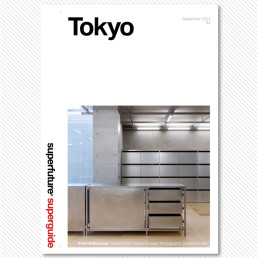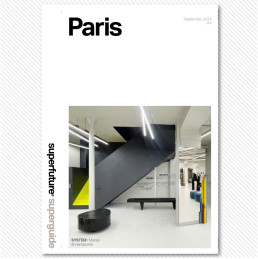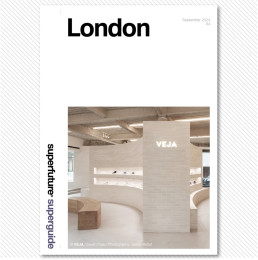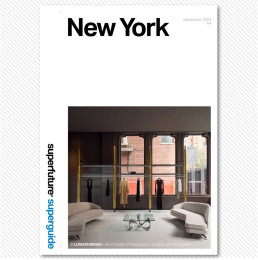
Originally from Guangzhou, 29-year-old Sean Wu is a creative professional based in Shanghai whose work is inextricably linked to his home country’s fast-evolving consumer market. A graduate from both the South China University of Technology in Guangzhou and Turin‘s Politecnico di Torino, Wu is part of a new generation of creatives who both voice and shape the sensibilities of today’s savvy young Chinese consumers through their creative output, setting new standards along the way. Next to his creative practice as an independent artist who creates installations crafted from sustainable materials, Wu has founded WILD Creative, a Shanghai-based agency focusing on creative design, content marketing and digital comprehensive solutions. In the latter capacity, Wu has firmly embedded himself and his company in the city’s flourishing creative scene. Operating on the intersection of art, design and technology, he fosters a growing list of renowned clients, such as Audemars Piguet, Aesop, New Balance, and Luisa Via Roma.
You’re both a contemporary artist and you also manage a creative agency. Please tell us about both fields, and more importantly, how you manage to juggle both careers? In my own artistic practice, I strive to express more of my own ideas, whether it’s the contemporary interpretation of Chinese culture or sustainable initiatives. When working with clients in my creative agency, I attempt to address their needs through creative and innovative ways. In fact, the fundamental difference between these two approaches lies in the fact that artistic creation revolves more around myself, whereas providing creative services requires me to consider the client’s perspective. However, I’ve found that experiences in both directions fuel and inspire each other. I try to infuse my artistic creations into my various projects. The experience working with consumers also taught me a great deal about how artworks can connect with people.
You have two different hats on which is fascinating. Are there instances in your creative practice, either as a designer/entrepreneur or as an artist, where this dual career trajectory has added value? Indeed, I believe my experiences in both areas contribute significant value to my overall creative practice. My collaborations with brands and companies have provided invaluable insights into human behaviour and preferences. Many people I’ve encountered have a keen interest in art and design. Since my own artworks are often public installations, my ability to easily connect with people has proven immensely beneficial. It enables me to adopt a broader perspective, extending even beyond my personal ideas. It also adds a societal value to the artwork since it’s almost an observation on human interaction.
China’s consumer market has seen a tremendous maturation in the past two decades. How has this influenced the dynamic of the creative fields you operate in, especially the design industry? First of all, I believe that the increasing diversity of social media platforms allows designers and creative professionals to more directly observe how their work is being evaluated and shared within social media. The vibrant development of the consumer market has led more international brands to value the Chinese market and strive to engage with Chinese consumers. Simultaneously, China has witnessed the emergence of various new consumer brands, often relying on innovative visuals to attract consumers’ favour and attention. These two trends, along with the influence of social media on consumer behaviour, have collectively accelerated the development of China‘s design industry more rapidly than before.

Given the size of the Chinese market, many foreign brands have flocked there to set up shop. What are the prerequisites as a foreign brand to be successful there in terms of brand communication and image? I believe that brands should first make an effort to genuinely understand Chinese culture and respect local traditions before attempting to communicate with Chinese consumers. We’ve seen brands trying to incorporate certain Chinese cultural symbols, such as zodiac signs and traditional colour schemes. However, due to a lack of thorough understanding, these efforts have often resulted in designs that are generally perceived as merely symbolic gestures. I think that brands need to consider the consumer’s habits and culture in the whole creative process, from the design of the product to the local marketing strategies.
Gen Z and Millennials are a major driving force in the consumption of high-end goods in China. They used to be influenced by contemporaries in Japan and South Korea, but now seem to have found their own identity. Do you envisage an era in which Chinese youth become a force themselves and thus influential worldwide? Without a doubt, I’ve noticed a growing appreciation for Chinese culture among young people in China. This trend is evident in the increasing focus of artists, filmmakers, and writers on traditional Chinese culture, interpreting it through their own unique perspectives. In my own artistic endeavours, I strive to express my understanding of Chinese culture in abstract forms, a practice that has struck a chord with many young people as well.
How is China’s own creative industry capitalising on the country’s rise as a luxury market, the sheer size of it, its dynamic, and its large talent? What do you think needs to be done to make it a global player? I believe a crucial aspect in distinguishing the creative industry here is to centre on defining the new Chinese identity. Visually, China boasts a profound history and a rich creative legacy. Presently, the country’s luxury market is dominated by Western brands. Given the vast consumer base, I see ample opportunities for artists and designers to forge a fresh outlook on Chinese aesthetics, departing from traditional representations while devising innovative methods to showcase the culture to a global audience.
The Chinese education system is largely state-run. Has the system’s division dedicated to art and design kept abreast with developments in society and the consumer market? There are indeed higher education institutions dedicated to art and design, but I believe it would be beneficial to provide younger individuals, from elementary school to high school, with greater access to resources in art and design. It’s of course linked to the test system in China, but I think art education is the most beneficial to students if they can practice it early on.
It’s safe to say, Shanghai is China’s creative capital. What’s the appeal of the city to you as both a city dweller and as an artist and entrepreneur? I think Shanghai is one of the most significant creative cities in China, with a large number of museums, galleries, and cultural institutions. As an artist, the exposure to art from all over the world is definitely a benefit. It also has a unique creative energy from all the individuals with international backgrounds. Shanghai is also the Chinese hub for many international brands. As an entrepreneur, it’s easy for me to spot industry trends and meet creative people from all industries.
How would you compare the creative industry in Shanghai to the other creative scenes in China’s first-tier cities? Compared to other cities, Shanghai boasts the richest and most comprehensive creative industry ecosystem. Here, brands from various sectors such as fashion, consumer goods, jewelry and watches, automobiles, and more require creative services. Additionally, there are a lot of artists, designers, and creatives working independently. They have diverse cultural backgrounds which add to the creative dynamic in the city.
Can you spill the beans on your favourite spots in the city, be it shops, restaurants, galleries, and what not? I’ll pick one for each category. So, I like shopping at DOE, and one of my favourite restaurants is Xin Rong Ji, an upscale diner serving Taizhou and Cantonese cuisine. Also, ShanghART is a great gallery which showcases many avant-garde Chinese artists. © superfuture.com

Publishers Note
Just to be clear – superfuture® is a design blog and not a political commentator. No surprise there. The scope of our content has always been global and borderless, however that can often mean covering projects in countries where we will not agree with the politics or actions of those countries. In a world that’s as screwed up as ever right now, the focus of our support is to those designers, architects and other creatives who aim to make the world a more liveable one – as opposed to people that try their hardest to destroy it. So if a project hits our desk and we like it based on its design credentials, we may choose to publish regardless of its location or creators nationality. superfuture® has always been inclusive and hopes for all current wars, aggression, violence, hate and extremism to end.





